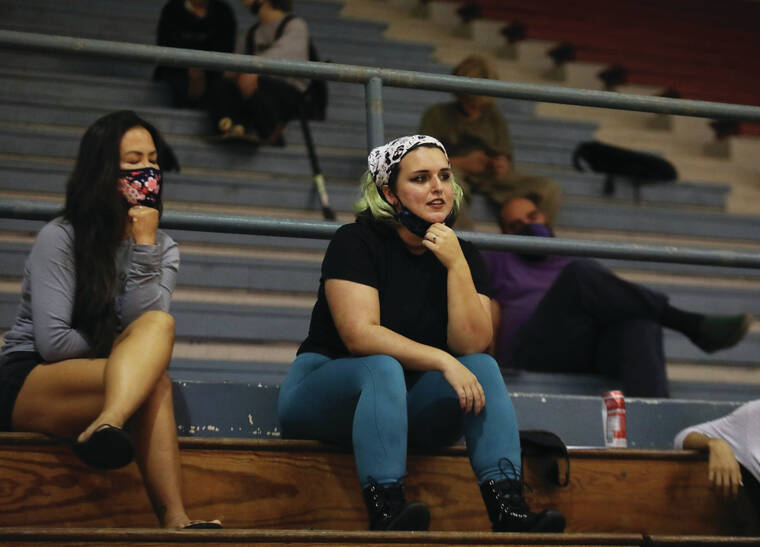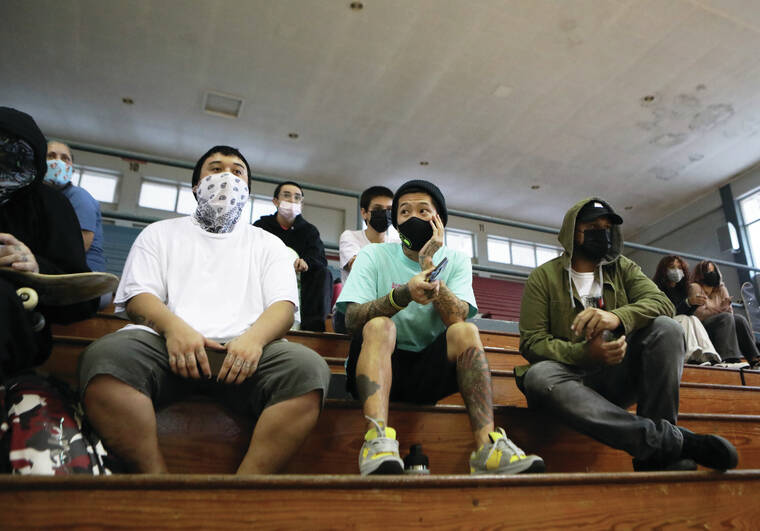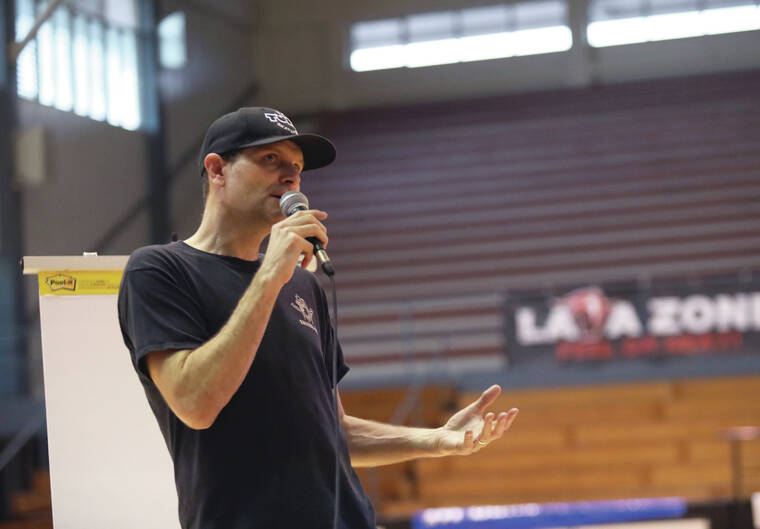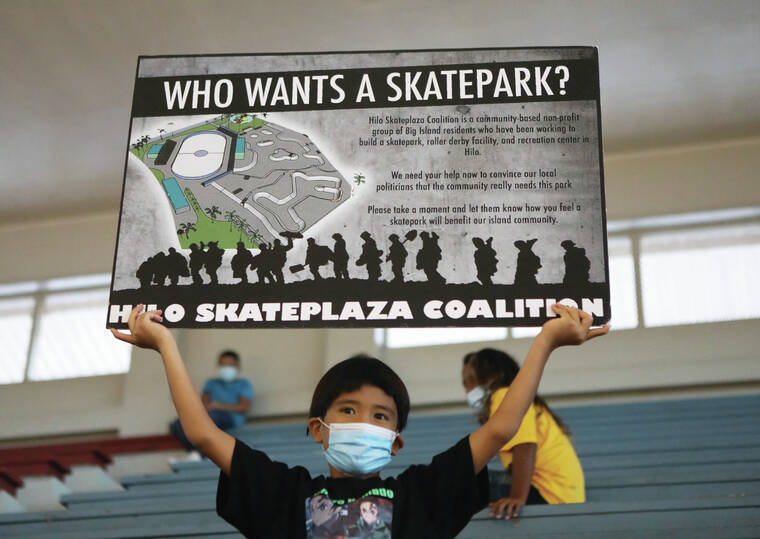Hilo skatepark mulled

Kelsey Walling/Tribune-Herald Denali Kirk gives an idea for the future Hilo skatepark during a community meeting at Afook-Chinen Civic Auditorium on Wednesday.

Kelsey Walling/Tribune-Herald Meeting attendees listen to opening remarks from Hawaii County Parks and Recreation director Maurice Messina during a community meeting to discuss the future Hilo skatepark at Afook-Chinen Civic Auditorium on Wednesday.

Kelsey Walling/Tribune-Herald Micah Shapiro talks about different options for building a skatepark in Hilo. Shapiro is with Grindline, a company that designs and builds skateparks around the world.

Kelsey Walling/Tribune-Herald Elena Hill asks a question Wednesday during a meeting to discuss building a skatepark in Hilo.

Kelsey Walling/Tribune-Herald Hajime Inoue holds up a sign for the Hilo Skateplaza Coalition during a community meeting Wednesday night at the at Afook-Chinen Civic Auditorium to discuss the future of the Hilo skatepark. The coalition is a nonprofit made up of community residents who have been working to build a skate facility.
“If you build it, they will come.”
“If you build it, they will come.”
That paraphrased line from the movie “Field of Dreams” is what one member of the public — a man wearing inline skates, carrying a helmet and hockey stick, his young son in tow — told county officials and the CEO of the nation’s largest skatepark design and construction firm Wednesday afternoon.
ADVERTISING
About 70 people, including members of the Hilo Skateplaza Coalition, attended a meeting best described as a brainstorming session about the design of a long-hoped-for skatepark to be built on about 2.5 acres of undeveloped county land across from the Afook-Chinen Civic Auditorium, where the meeting was held.
County Parks and Recreation Director Maurice Messina told those assembled the county is providing the land for free, and an environmental assessment for the proposed project is in progress.
Emi Tanitomi, a project manager for Bow Engineering and Development — the consultant preparing the EA — was in attendance, as was County Councilwoman Sue Lee Loy of Hilo.
“We understand the need for skating,” Messina said. “What’s happening right now in Hilo? Where are all the skaters going? They’re going to the canoe areas. They’re on the sidewalks. They’re on the streets. So, our job — and we’ve been working with our partners for so long — is to bring a skatepark to Hilo.
“… At Parks and Recreation, we have made a commitment to do our best to get at least one skatepark in every district on this island. We’re working with different community groups. And this has been the longest community without a skatepark since we’ve started this.”
The Hilo Skateplaza Coalition has been working on getting a public skatepark built in Hilo since 2008, one member said.
Messina called the skatepark, which is still very much in the conceptual phase, a “prime definition of a public-private partnership.”
“We’re going to need a bunch of help from the community. We’re going to need some fundraising help,” he said. “What we’re going to provide is parking, comfort stations and other amenities” required by the Americans With Disabilities Act.
He added a roller derby track and a playground would be a part of the design, as well.
Micah Shapiro, CEO of Grindline, a Seattle company he said has built about 100 skateparks nationwide, presented a slide show featuring a number of skateparks his firm has built — including the North Houston skatepark in Texas, which at 78,000 square feet is the largest skatepark in the country.
He also presented photos of more modest and accessible designs in the 10,000- to 15,000-square-foot range.
An architectural drawing of a possible design was shown, but Shapiro made it clear nothing was set in stone, design-wise, saying any design needs to be appropriate for Hilo.
“We want you guys to participate in the process,” Shapiro said. “We’re not here to say, ‘Hey look, this is what you’re getting.’ This is your park. You’re going to be the ones who use it on a daily basis.”
Shapiro said the goal is a “timeless design, something beautiful, something sustainable.” He added the design phase of the project would take between six months and a year.
“We want it to be so it isn’t a homeless hangout, it isn’t a drug hangout,” added Messina. “It’s something that everybody can see when they drive by here.”
As Shapiro solicited suggestions from attendees, one feature unique to a Hilo skatepark came up several times — a roof, since Hilo is the U.S.’s rainiest city, with average yearly rainfall about thrice that of Seattle.
Asked for an estimate of construction costs, Shapiro replied “about $75 a square foot.” That translates to $750,000 for a 10,000-square-foot park and $1.125 million for a 15,000-square-foot facility.
“I feel like people are getting daunted by a million dollars — and none of us have that,” noted one attendee.
Said another, “People are raising a lot of money, and they’re seeing it go into ‘not concrete.’”
According to Messina, the Honokaa community contributed about $200,000 to a skatepark built there.
The ideas of grant proposals and commercial sponsorships came up, and Messina said Hawaiian Airlines is contributing to the refurbishing of a currently unusable high-dive platform at the county’s Sparky Kawamoto Swim Stadium in return for placement of the airline’s logo on the side of the platform.
Added Shapiro, “I’ve seen (surf wear giant) Vans occasionally kick in, like $50,000 for a project.”
An attendee mentioned the Tony Hawk Foundation, which provides grants for skateparks in underserved communities.
“You need to raise 20% of the project’s cost before you go to the Tony Hawk Foundation,” Shapiro replied. “Then, they know you’re serious.”
The inline skater with the young son underscored his own need and desire for a skatepark to be built.
“It’s illegal to skate on the roads here,” he said. “I skate six to 12 miles a day on the road. I’m breaking the law when I skate.”
Email John Burnett at jburnett@hawaiitribune-herald.com.


